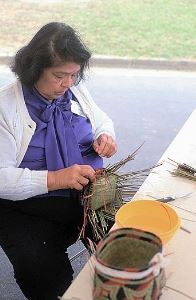Ada Thomas facts for kids
Quick facts for kids
Ada Thomas
|
|
|---|---|

Ada Thomas weaving traditional double-woven Chitimacha baskets
|
|
| Born |
Ada Vilcan
July 31, 1924 Chitimacha Reservation, St. Mary Parish, Louisiana
|
| Died | September 6, 1992 (aged 68) |
| Nationality | American |
| Other names | Ada Vilcan Thomas |
| Occupation | weaver |
| Years active | 1970–1992 |
| Known for | double-weave baskets |
Ada Thomas (born July 31, 1924 – died September 6, 1992) was a talented Chitimachan basket weaver. She was especially good at making "double-weave" baskets using split rivercane. Her amazing work earned her a special award called the National Heritage Fellowship in 1983. This award is given by the National Endowment for the Arts to honor traditional artists. You can find her beautiful baskets in famous places like the Metropolitan Museum of Art in New York City.
Contents
Early Life and Learning to Weave
Ada Vilcan was born on July 31, 1924. Her family lived on the Chitimacha Reservation, which is a special area for the Chitimacha people, near Charenton, Louisiana. She was one of six children.
Ada went to elementary school on the reservation. There, she learned the unique art of Chitimacha basket weaving from older women. Her teachers included Christine Navarro Paul and Pauline.
What Makes Chitimacha Baskets Special?
Chitimacha baskets are very unique because they are "double-woven." This means they are like two separate baskets woven together. The patterns on the inside and outside of the basket are different!
Weavers use thin strips of split cane, which is a type of bamboo, called piya by the local people. They dye these strips with natural materials. Walnut gives a black color, a plant root called "la passiance" makes red, and lime creates yellow.
These colored strips are woven into designs that often show animals from the bayou. You might see alligators, blackbirds, cows' eyes, hearts, perch fish, snakes, and turtles in the patterns.
The plain inner basket is woven first. Once the top edge is reached, the basket is turned. Then, the outer basket is woven from the rim back down to the bottom, adding the colorful designs.
Ada's Career and Return to Weaving
After finishing school on the reservation, Ada moved to New Orleans. During World War II, she worked in a factory that made parts for airplanes. Even though schools were separated by race back then, she was able to go to night school. This allowed her to earn her high school diploma.
After school, Ada traveled around the country. She worked in places like Washington, D. C., New York City, and Miami, Florida. In Miami, she met and married Charles Thomas, a jeweler. They had three sons: Arthur, Charles Henry, and Raymond.
Saving a Tradition
When her husband passed away, Ada Thomas returned to the Chitimacha Reservation in 1970. She wanted to raise her young sons there. While her sons were at school, she started weaving baskets again. She wanted to bring back the craft she learned as a child.
When Ada was young, her tribe faced poverty, especially during the Great Depression. But by the 1970s, the oil industry had brought more money to the area. While this helped her people, it also meant that fewer people were practicing traditional crafts.
Ada was determined to save the special Chitimacha basket weaving techniques. She worked with Stephen Richmond from the Indian Arts and Crafts Board. They put together a show at Louisiana State University in Baton Rouge. Richmond also helped her get money to teach others how to weave.
In 1983, Ada Thomas was given the National Heritage Fellowship. This important award recognized her as a master of traditional arts.
Sharing Her Art
Ada taught basket weaving at schools in Charenton. She also went to many festivals to show her work and demonstrate the craft. These included the New Orleans Jazz and Heritage Festival and the Folklife Festival hosted by the Smithsonian. In her later years, she mostly made baskets for museums and private art collections.
Death and Legacy
Ada Thomas passed away on September 6, 1992, in Charenton. Her beautiful baskets are kept in the permanent collections of several important places. These include the Birmingham Museum of Art, the Metropolitan Museum of Art, and the Museum of International Folk Art in Santa Fe, New Mexico. Her work helps keep the Chitimacha weaving tradition alive for future generations.

